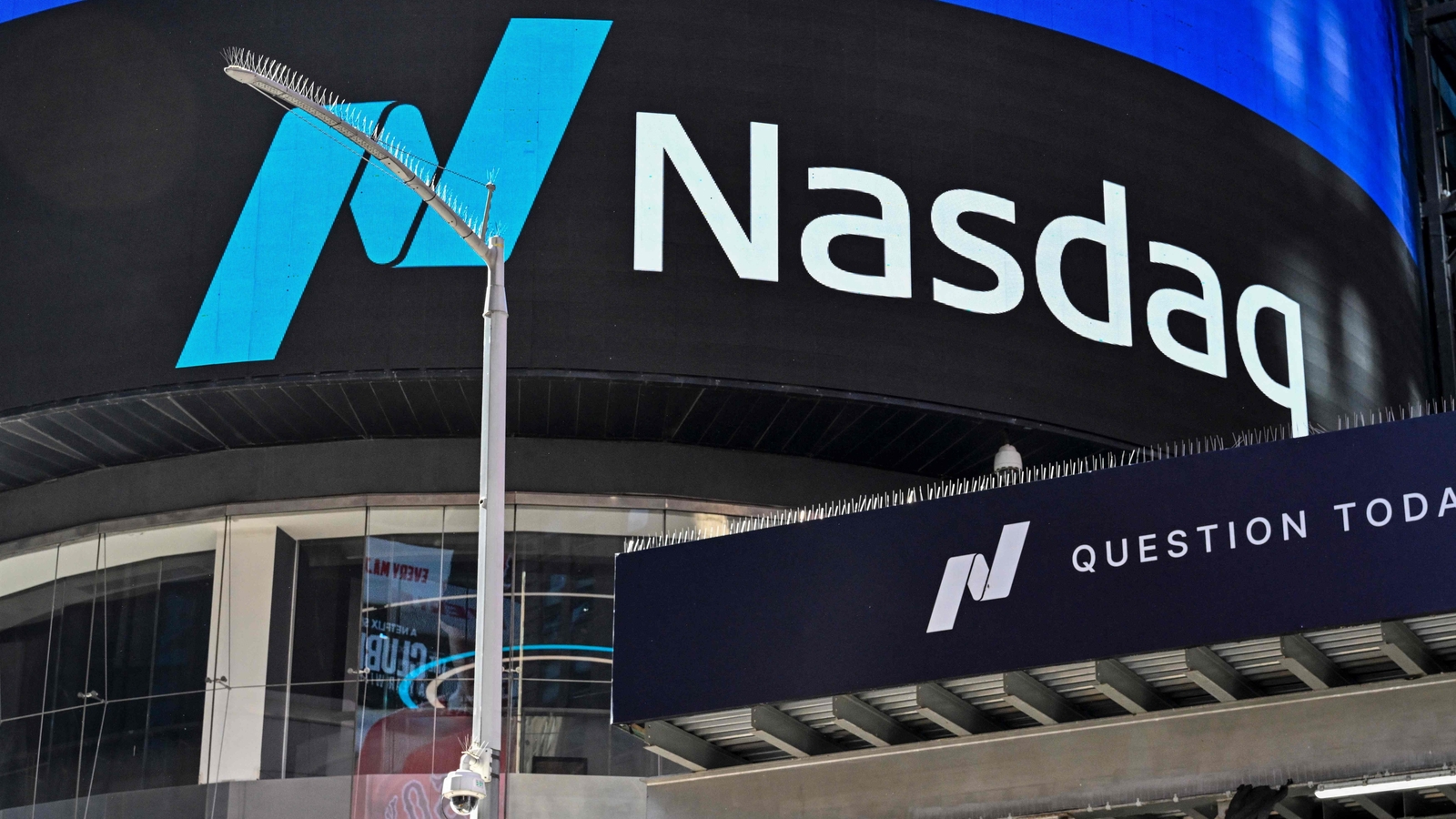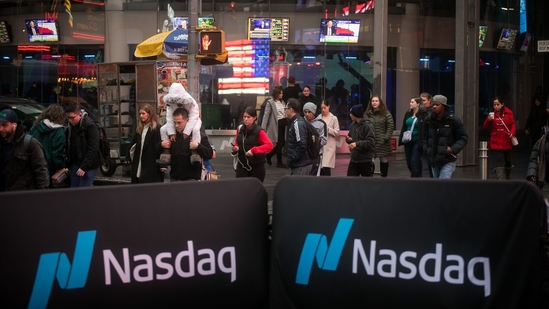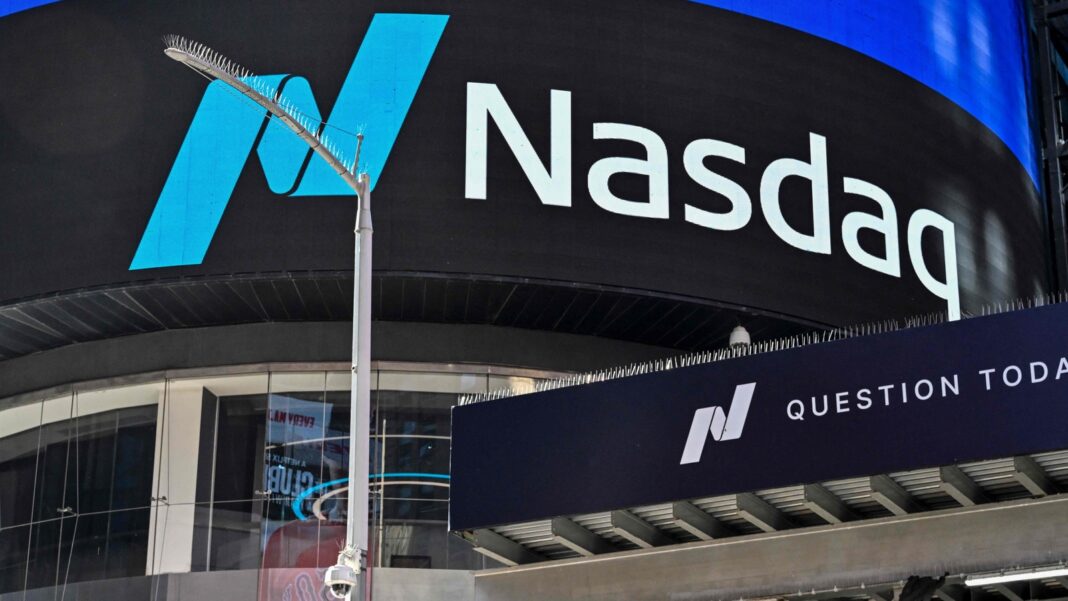## Green Across the Board: Is This the Start of a Nasdaq and Dow Surge? Have you noticed the market buzzing with optimism today? Major tech giants like Apple and Amazon are leading the charge, pushing their stock prices higher. But what’s driving this sudden surge? Is this a fleeting moment of good fortune or the beginning of a sustained rally? Hindustan Times takes a look at the factors behind today’s market highs and what they might mean for investors. Read on to understand if this green wave signals a new era for the Nasdaq and Dow.
Wall Street’s Surge: Deciphering the Impact of Trump’s Tariff Pause

The financial markets experienced a dramatic surge on Wednesday, driven by President Donald Trump’s announcement of a 90-day pause on some reciprocal tariffs. This unexpected move sent ripples through major indices, with the S&P 500, Dow Jones Industrial Average, and Nasdaq Composite all registering significant gains.

Trump’s Tariff Twist: A 90-Day Breathing Space
In a post on his Truth Social platform, Trump stated, “I have authorized a 90 day PAUSE, and a substantially lowered Reciprocal Tariff during this period, of 10%, also effective immediately.” He further revealed that he was raising tariffs on China to 125%. This announcement came amidst ongoing trade tensions and a history of fluctuating trade policies from the Trump administration.
Treasury Secretary Scott Bessent later clarified that the 90-day pause applied to all countries except China. The pause, however, does not extend to sector-specific tariffs. This nuanced approach suggests a targeted effort to de-escalate trade disputes while maintaining pressure on China.

Market Reaction: A Surge of Optimism
The market reacted with enthusiasm to Trump’s announcement, with all three major indices experiencing substantial gains. The S&P 500 surged 7.8%, the Dow Jones Industrial Average climbed 2544 points, or 6.8%, and the Nasdaq Composite jumped approximately 10%. This widespread rally indicates a strong positive sentiment towards the potential for reduced trade barriers and a more stable economic environment.
Individual stock performances highlighted the impact across sectors. Tech giants, particularly those listed on the Nasdaq, witnessed significant gains. Apple rose 11%, Nvidia soared 13%, Amazon climbed 7.5%, Alphabet increased 6.4%, and Microsoft surged 7.8%. These impressive performances underscore the sensitivity of tech stocks to trade policy changes and the sector’s reliance on a stable global trading environment.
Beyond the Headlines: Unpacking the Ripple Effects
The positive impact of Trump’s tariff pause extended beyond tech stocks, influencing other sectors as well. Airlines and travel companies experienced particularly strong growth, reflecting the potential for increased consumer spending and business travel. Delta Air Lines, which had released its first-quarter earnings earlier that day, saw its stock soar by more than 22%, putting it on track for its strongest performance since at least March 2020. United Airlines also experienced a significant uptick, climbing over 19%, heading toward its best day since May 2020. Southwest Airlines gained 12%, while JetBlue Airways and Alaska Air each rose more than 12%.
The travel site Expedia also saw its stock increase by over 15%, reflecting the broader rally in travel-related shares. This surge in the travel sector indicates increased consumer confidence and a rebound in travel demand, likely fueled by the expectation of reduced travel costs.
The long-term consequences of the tariff pause are still uncertain. While the immediate impact on the market has been positive, the broader economic outlook remains subject to various factors, including the outcome of trade negotiations with China and the overall global economic climate.
The Tech Titans: How Trump’s Move Benefited Their Bottom Lines
The dramatic surge in tech stocks, particularly those listed on the Nasdaq, in response to Trump’s announcement can be attributed to several key factors. The pause on tariffs directly reduces costs for tech companies that rely heavily on global supply chains. This offers a significant boost to profit margins and allows for greater investment in research and development.
Moreover, the reduced trade tensions create a more predictable and stable business environment. This stability encourages long-term planning and investment, which is crucial for the tech industry, known for its innovation cycles and capital-intensive projects.
Easing Supply Chain Pressures
Many tech companies, from Apple to Nvidia, rely on components sourced from countries impacted by the tariffs. This reliance creates vulnerability to price increases and supply chain disruptions. The tariff pause alleviates these pressures, allowing companies to secure components at more favorable prices and ensure a smoother flow of goods.
Boosting Consumer Confidence
The positive market reaction to Trump’s announcement also reflects a broader increase in consumer confidence. The expectation of reduced costs and increased economic stability encourages consumers to spend more, benefiting tech companies that rely on consumer demand for their products.
Encouraging Investment and Innovation
The reduced uncertainty surrounding trade policy creates a more favorable environment for investment in the tech sector. Investors are more likely to invest in companies with a clear path to profitability and growth, and the tariff pause provides that clarity. This increased investment fuels innovation and drives technological advancements.
Specific Examples: Apple, Nvidia, and Amazon
The performance of individual tech stocks vividly illustrates the impact of the tariff pause. Apple, a global leader in consumer electronics, saw its stock surge 11%. The company’s reliance on a global supply chain for components makes it particularly vulnerable to tariff increases. The pause allows Apple to maintain its competitive pricing and continue to grow its market share.
Nvidia, a leading provider of graphics processing units (GPUs) for gaming, data centers, and artificial intelligence, saw its stock soar 13%. Nvidia’s products are heavily reliant on global supply chains and the tariff pause significantly reduces its production costs. This boost in profitability allows Nvidia to invest further in research and development, driving innovation in the AI and gaming sectors.
Amazon, a global e-commerce giant and cloud computing provider, also experienced a significant gain of 7.5%. While Amazon’s operations are diversified, its reliance on global logistics and manufacturing makes it susceptible to tariff-related disruptions. The tariff pause alleviates these pressures, allowing Amazon to optimize its supply chain and maintain its competitive edge.
Tariff Tensions and Tech Vulnerability
Previous threats of tariffs posed a significant risk to tech companies heavily reliant on global supply chains and international markets. Tariffs imposed on imported components and finished goods would have directly increased production costs for tech manufacturers. These increased costs would have inevitably been passed on to consumers, potentially dampening demand for tech products and impacting company profitability.
The impact of tariffs on the tech industry extends beyond direct production costs. Tariffs can disrupt the intricate web of global supply chains that underpin the tech sector. Delays in receiving components from suppliers, coupled with increased transportation costs, can lead to production bottlenecks and ultimately hinder innovation. Moreover, tariffs can create uncertainty and discourage investment in new technologies and manufacturing facilities, potentially stifling long-term growth in the tech industry.
Nvidia in the Spotlight: A Chip Aversion Story
Nvidia, a leading manufacturer of graphics processing units (GPUs) crucial for AI development, faced specific concerns regarding the potential for Chinese competition to erode its dominance in the AI chip market. The emergence of DeepSeek, a Chinese startup, with a cheaper and arguably competitive AI model built using Nvidia’s less advanced H800 chips, fueled investor anxieties. DeepSeek’s V3 model, which became the top iPhone download in the U.S., demonstrated the viability of cost-effective AI solutions, prompting concerns about Nvidia’s market share and future prospects.
Prior to Trump’s announcement, Nvidia’s stock price experienced a significant drop, reflecting investor concerns about the potential impact of DeepSeek’s AI model. The company’s heavy investment in AI research and development, coupled with the emergence of a cheaper alternative, created a sense of vulnerability in the market. Nvidia’s stock price decline underscored the growing competition in the AI chip market and the potential for disruption from emerging players.
Looking Ahead: Navigating Uncertainty in the Post-Tariff Pause Era
While the 90-day tariff pause provides a temporary reprieve, the long-term implications for the tech industry remain uncertain. The success of future negotiations between the U.S. and individual countries will be crucial in determining the future direction of trade policy and its impact on the tech sector.
Negotiation Prospects: A Fragile Path Forward
The negotiations between the U.S. and individual countries will be complex and multifaceted, requiring careful consideration of economic, political, and strategic factors. The ability of both sides to find common ground and reach mutually beneficial agreements will be essential for avoiding renewed trade tensions and maintaining global economic stability.
The success of these negotiations will depend on a number of factors, including the willingness of both sides to compromise, the ability to address underlying structural issues in the global trading system, and the broader geopolitical context. The outcome of these negotiations will have significant implications for the tech industry, as well as for the global economy as a whole.
Market Volatility: Riding the Rollercoaster
The 90-day tariff pause has provided a temporary boost to market sentiment, but the uncertainty surrounding trade policy is likely to continue to cause volatility in the coming months. Investors will be closely watching the progress of negotiations and adjusting their portfolios accordingly.
Long-term investors should focus on maintaining a diversified portfolio and adhering to their investment strategy. Short-term market fluctuations should be viewed as opportunities to potentially rebalance or adjust positions.
It is important to remember that market volatility is a normal part of the investment cycle. By staying informed and disciplined, investors can navigate these choppy waters and position themselves for long-term success.
Conclusion
In our analysis of the current market trends, we’ve seen a significant surge in major Nasdaq and Dow stocks, with Apple and Amazon being at the forefront of this movement. The article breaks down the factors contributing to this upswing, including the decline of interest rates, improved economic outlook, and a shift in investor sentiment. Key players in the tech sector, such as Apple and Amazon, have seen their stocks rise as investors become increasingly optimistic about the future of the industry.
The significance of this trend cannot be overstated, as it has far-reaching implications for the global economy and the tech sector in particular. As major players continue to perform well, it’s possible that we’ll see a sustained rally in the coming weeks and months. This trend also highlights the growing importance of tech stocks in the broader market, with many seeing them as a safe-haven asset in times of economic uncertainty.
As we look to the future, it’s likely that the tech sector will continue to drive market momentum. With emerging technologies like AI, blockchain, and the Internet of Things (IoT) on the horizon, it’s not hard to see why investors are betting big on the future of tech. But as we celebrate the rise of these industry titans, we must also remember that this trend is not without its risks. As the market continues to evolve, it’s essential for investors to stay informed and adapt to changing circumstances. As the old adage goes: “only time will tell if this trend will last, but one thing is certain – the future of tech is here, and it’s here to stay.”
